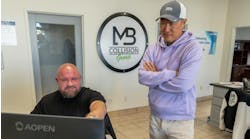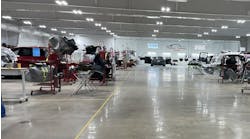Both major and minor changes in procedures and equipment are enabling shops to work faster and more efficiently.
Spurred by the intense competition for the repair dollar, auto body shops are constantly on the lookout for ways to increase productivity. Sometimes it’s a minor adjustment in procedures; other times it may be a new piece of equipment. And once in a while, it requires a major change in management policy.
Hank Nunn is a believer in the latter. Through HW Nunn and Associates, he has provided management training to the collision repair industry since 1988. Nunn has been a technician, a collision shop owner and jobber store owner.
“In my travels I visit a lot of shops,” says Nunn. “While many of the new timesaving tools and equipment are great, the biggest impediment to rapid production in the paint shop is poor management. No super tool or rapid dry primer is going to fix that.”
Poor management usually manifests itself in delays—stopping and starting the repair process. “The average collision shop technician is spending 25 percent of his time out of his designated workspace,” says Nunn. “That’s time spent doing something besides creating billed hours.”
The reasons technicians spend so many hours away from actual work are numerous: parts problems, missed items or operations, employee issues, equipment shortages, scheduling issues, re-inspection delays.
“It really doesn’t matter if we’re repairing collision damaged vehicles, building boats or repairing shoes,” Nunn says. “Every time we stop and start again, we incur added costs, hurt cycle time and lose money.”
Many shop owners and managers have instituted processes designed to uncover the reasons for these interruptions. Those processes go by various names, including triage, staging, pre-production management and pre-repair management.
Whatever it’s called, this procedure isn’t suited for every shop. It requires a commitment of manpower, equipment and floor space, and many shops are short of one, two or all three of these. What’s more, the procedure is aimed at managing the entire repair, not just the refinish operation. Since we’re dealing strictly with the paint shop here, let’s leave discussion of pre-repair management for another issue and focus on refinishing work.
The paint shop at Fix Auto in Anaheim, Calif., follows a procedure that helps reduce the dreaded stop-and-start cycle that Nunn warns against. Each technician except the painter (who spends all his time in the booth or mixing paint) has his or her own parts cart, which he stocks each morning. “They have everything they’ll need for the day,” explains Refinish Paint Manager Todd Burdette. “So there is no going back for masking tape or whatever.” It should be noted this is not unique to the Fix Anaheim location, but it is a procedure many successful shops have adopted.
Burdette also believes in specialization—another characteristic of many top shops. “We have two technicians who do our prep work, and one who does nothing but jambs,” he says. Longevity also is important. Each technician has worked with Burdette for several years, so they know exactly what is required. As a result, the six-man shop produces an impressive 12-14 cars per day.
Small Changes, Significant Gains
In addition to personnel-related procedures, there are several other ways in which you can fine-tune your shop to make it more productive.
One growing trend in the industry is the practice of painting parts off the car. Replacement parts like fenders, hoods, deck lids, bumper covers, spoilers and other bolted-on items are “cut in,” “jambed” or “trimmed out” (inside surfaces painted) off the vehicle. The exteriors are then painted after being installed so that all exterior painting is done at the same time, and the repair is blended into adjacent panels.
Parts racks or stands for holding parts come in various forms from several suppliers. Rotating racks for hoods and similar parts allow the painter to spray the bottom of the part, then flip the rack over and paint the top. There also are tilt tables, bumper holders, paint hangers, panel racks and racks for spoiler adapters. Some shops simply place the part on top of a 55-gal. drum with a tire on top for padding.
“We’ve been [painting parts off the vehicle] more and more,” says Derek Speerstra, paint shop manager at Fix Auto in Ontario, Calif. “We’ve found that we can eliminate a whole day from the process. It used to be that we took a day to prime, another day to jamb, and then a day to reassemble. This eliminates the jambing and reassembly.”
Says Bill Wynkoop, owner of Auto Rehab Crash 1 in Rockford, Ill. “If you paint parts off the car, you’re putting the primer in the gun once, you’re putting the paint in once, and you’re putting the clear in once, and you prepare and mix all those materials once—instead of twice.”
Chuck Sulkala, owner of Acme Body and Paint shop in Jamaica Plains, Mass., started painting parts off the car a few years ago at the suggestion of Shop Manager Mike Johnson. “We do much better work now than we did four or five years ago,” says Sulkala. “That’s because the job is better looking, with no rough edges, no evidence of masking.”
Johnson adds that the process saves on labor and material. “If you’re doing a fender, for instance, you paint the jamb, then hook it onto the car, then mask it off, paint it, then deal with the overspray on either side,” he says. “That means you have to re-sand and usually mask again. If you paint it off the car, it’s all done in one step.”
Plastic parts, such as front and rear bumper covers, are particularly suited to being painted off the car. They’re difficult to paint uniformly because of their crevices and recesses, and they require different cleaning procedures and flexible adhesion products that aren’t needed for sheet metal parts. Also, it’s often difficult to install a bumper cover, then “flex” the clear and not allow the flex additive to affect adjacent sheet metal panels.
In Wynkoop’s shop, the goal is to do no jambing at all. “Once in a while,” he says, “a technician will say he’s more comfortable with jambing a part, so we’ll let him go ahead and do it. Usually, though, if he’s installing an already painted part and he scratches it, the painter can easily spot it in.” Even with the need for an additional small repair, he points out off-the-car painting is still a more productive method. That’s because any slowdown in the metal shop due to handling a pre-painted part can be more than made up in the paint department. Essentially, the painters are working at twice their normal efficiency.
As Speerstra points out, body techs aren’t fans of this new trend because it requires them not only to fit parts onto a car, but also to do so without chipping the paint. However, today’s finishes are tough and chip resistant, and a good metal man should be able to put a part on a car without damaging it.
Keeping a Chart
Another time-saver involves the hiding problem presented by the advent of transparent OEM colors. “We deal with a new Corvette color that’s bright yellow and takes about nine coats to cover,” says Burdette at Fix Auto. Coverage becomes an even bigger problem when the tech is painting over a dark gray primer spot. To cover in fewer coats, his shop combines a little white with some yellow to spray over the primer. “White covers fast, so when we put our yellow over it, we’re not trying to cover a dark gray,” he says. “We keep a journal or log on what colors are transparent and what we need to help them cover faster. Then we keep those colors on hand.”
On a recent pink job (another tough-to-cover color), his painter sealed the whole car with a tintable sealer that accepts up to 10 percent of a toner. “That really cut down on the number of coats we needed to cover, so we used less paint,” he says. “If it used to take a quart to paint a fender, we can do it now with a pint by using the tintable sealer. Less paint means less money. Paint now is about $80 a quart, and the sealer is about half that.” Result: savings in time and money.
The computerized paint mixing system offered by a major paint manufacturer also is boosting production in many shops. The software tells the mixing machine exactly how much paint to mix for each job, so there are no overpours, no recalibrating. At Kay Parks/Dan Meyer Auto Rebuild in Tacoma, Wash., Head Painter Bruce Fraser estimates that the system has reduced tinting dramatically since it was installed in late 2002. “Before, we had to tint about 30 percent of our paint mixes,” says Fraser. “The computer system has cut that to about 5 percent.” The shop does 130 repairs or more a month, so the resultant drop in material usage and hazardous waste is significant. The reduction in tinting also means guns require less cleaning, another time-saver.
A more recent development, disposable cup liners for high volume low pressure spray guns, has had an even bigger impact on gun cleaning. As part of a unit that includes a filter and a spray gun adapter, this system is virtually contaminant-free. Painters simply throw away the liner after a job, so guns rarely have to be cleaned.
Another new product, plural component spray guns, is recommended by Steve Lebron. Lebron’s company, Custom Layout and Design, in Tekamah, Neb., designs approximately 100 shops a year. He calls the guns “mini mixing machines.” They use a proportional pump that mixes the color or clear with its activator at the nozzle. “These systems save material and time,” he says.
Other time-savers recommended by Lebron include overhead infrared drying lamps, plus portable infrared units, and, if possible, a computer for every technician. With a computer, technicians can stay up-to-date on all jobs in the shop, and they can use it to punch in and out of work.
Mask It Fast
The masking step also is undergoing changes aimed at efficiency. Treated plastic sheeting, for instance, prevents solvent bleed through, and ensures against paint flaking during the demasking process. It comes in several sizes of pre-folded drape plastic film rolls, and it can be unrolled from a convenient, hand-held masking dispenser. “Plastic sheeting allows you to mask right up to the critical paint edge and eliminate the need for the 12- or 18-inch masking paper border,” says Tim Hines, senior market manager, NAPA Tools & Equipment/ Paint & Body. “Not only is the cost of the masking paper eliminated, but more importantly the labor time is reduced significantly because an entire step is eliminated.”
Many shops also have discovered liquid spray mask. After18-inch paper is applied next to the repair area, the liquid mask is sprayed on the rest of the vehicle with conventional spray equipment. It easily covers hard to reach areas, protecting them from overspray, and it washes off after the paint has dried. One gallon covers approximately five cars.
Those are just a few ideas for boosting production. To stay current on tools and procedures that can help you crank out cars faster, stay in touch with suppliers and take advantage of any training they offer. And for the serious-minded, consider reading The Toyota Way, by Jeffery K Liker. (McGraw Hill). m



